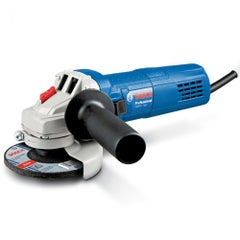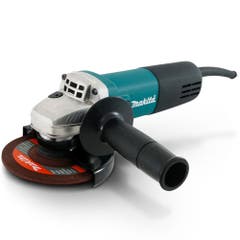Angle Grinders
Looking to enhance your toolkit? Discover the power and precision of angle grinders. From mini angle grinders for intricate work to heavy-duty angle grinder cutters, these tools offer endless possibilities. Learn the artful usage of angle grinders to shape, cut, and polish effortlessly. Whether you're a pro or a DIY enthusiast, our comprehensive range has the perfect angle grinder tool for every project. Elevate your craftsmanship today!
Shop by Product Type
Choose the Right Angle Grinder for Your Needs!
Looking for the ideal angle grinder to tackle your projects? Our comprehensive guide helps you navigate through the options and pick the right one. From cutting to grinding, find the tool that suits your needs. Don't compromise on quality or performance. Browse our selection to make an informed choice and get your tasks done effortlessly. Your ultimate angle grinder solution awaits!
Different Types of Angle Grinders Available at Total Tools
Total Tools offers a diverse selection of angle grinders to meet your specific needs. Whether it's cutting, grinding, or polishing, we have the right tool for the job. Our wide variety ensures you'll find the perfect fit for any project. Don't miss out on quality and variety – discover the different types of angle grinders available at Total Tools today:
Mastering the Usage of Angle Grinders: Safety Tips and Techniques
Step 1: Gather Your Safety Gear
Before you start using an angle grinder, ensure you have the necessary safety equipment:
- Safety goggles or a face shield to protect your eyes and face from sparks and debris.
- Hearing protection to safeguard against the loud noise generated by the grinder.
- Heavy-duty gloves to shield your hands from potential burns or cuts.
- Long-sleeved clothing and closed-toe shoes to prevent sparks from reaching your skin.
Step 2: Choose the Right Angle Grinder
Select an angle grinder that suits your project's requirements. Consider factors like disc size, motor power, and speed ratings. Make sure the grinder is compatible with the type of discs you'll be using.
Step 3: Inspect the Grinder and Disc
Before usage, examine the grinder for any visible damage, loose parts, or frayed cords. Check the condition of the grinding or cutting disc to ensure it's not cracked or worn out. Only use a disc that's in good condition.
Step 4: Choose the Appropriate Disc
Different tasks require different discs – cutting, grinding, polishing, etc. Make sure to install the appropriate disc securely and according to the manufacturer's instructions.
Step 5: Secure Your Workspace
Set up your workspace in a well-ventilated area with ample lighting. Clear away clutter and flammable materials. Ensure a stable work surface to prevent accidents while using the angle grinder.
Step 6: Position Yourself
Stand in a balanced stance with your feet shoulder-width apart. Keep a firm grip on the grinder with both hands, maintaining a comfortable and controlled posture.
Step 7: Start Slowly
Turn on the grinder and let it reach full speed before bringing it in contact with the workpiece. Don't apply excessive pressure initially; let the grinder's weight and speed do the work.
Step 8: Maintain a Consistent Angle
For cutting or grinding, maintain a consistent angle between the grinder and the workpiece. Avoid tilting the grinder too much, as it can cause uneven results and increase the risk of accidents.
Step 9: Move Smoothly
Move the angle grinder smoothly and steadily along the intended path. Avoid sudden or jerky movements that could lead to kickback or loss of control.
Step 10: Use Both Hands
Always use both hands to control the grinder. This provides better stability and control over the tool's movement.
Step 11: Wear a Respirator for Dust
If you're working on a task that generates dust (such as cutting concrete), wear a respirator to protect your lungs from harmful particles.
Step 12: Turn Off and Disconnect
Once you've completed the task, switch off the grinder and disconnect it from the power source. Wait for the disc to come to a complete stop before setting the tool down.
Exploring Top-Rated Angle Grinder Brands for Quality Performance
- Makita
- Milwaukee
- Bosch
- DeWalt
- HiKOKI
- Aeropro
FAQs (Frequently Asked Questions):
How to use an angle grinder?
To use an angle grinder effectively and safely, begin by wearing essential safety gear, including goggles, gloves, and hearing protection. Choose the right angle grinder for your task and assemble it by attaching the appropriate grinding or cutting disc. Set up a well-ventilated workspace and stand in a balanced stance with your feet apart. Start the grinder and let it reach full speed before bringing it in contact with the workpiece. Maintain a consistent angle and smooth movements while applying gentle pressure. Once done, turn off the grinder, let the disc come to a complete stop, and inspect your work. Always prioritize safety, and practice on scrap material if you're new to using an angle grinder.
What is an angle grinder used for?
An angle grinder is a versatile handheld power tool used for various tasks in construction, metalwork, and fabrication. It is equipped with a rotating abrasive or cutting disc that can be interchanged based on the intended application. Angle grinders are primarily used for cutting, grinding, and polishing materials such as metal, concrete, tile, and stone. They are essential for tasks like cutting through metal pipes, removing rust or paint, shaping and smoothing metal surfaces, and even cutting masonry for construction projects. With the ability to handle different types of abrasive discs, angle grinders offer a wide range of applications, making them indispensable tools for professionals and DIY enthusiasts alike.









































